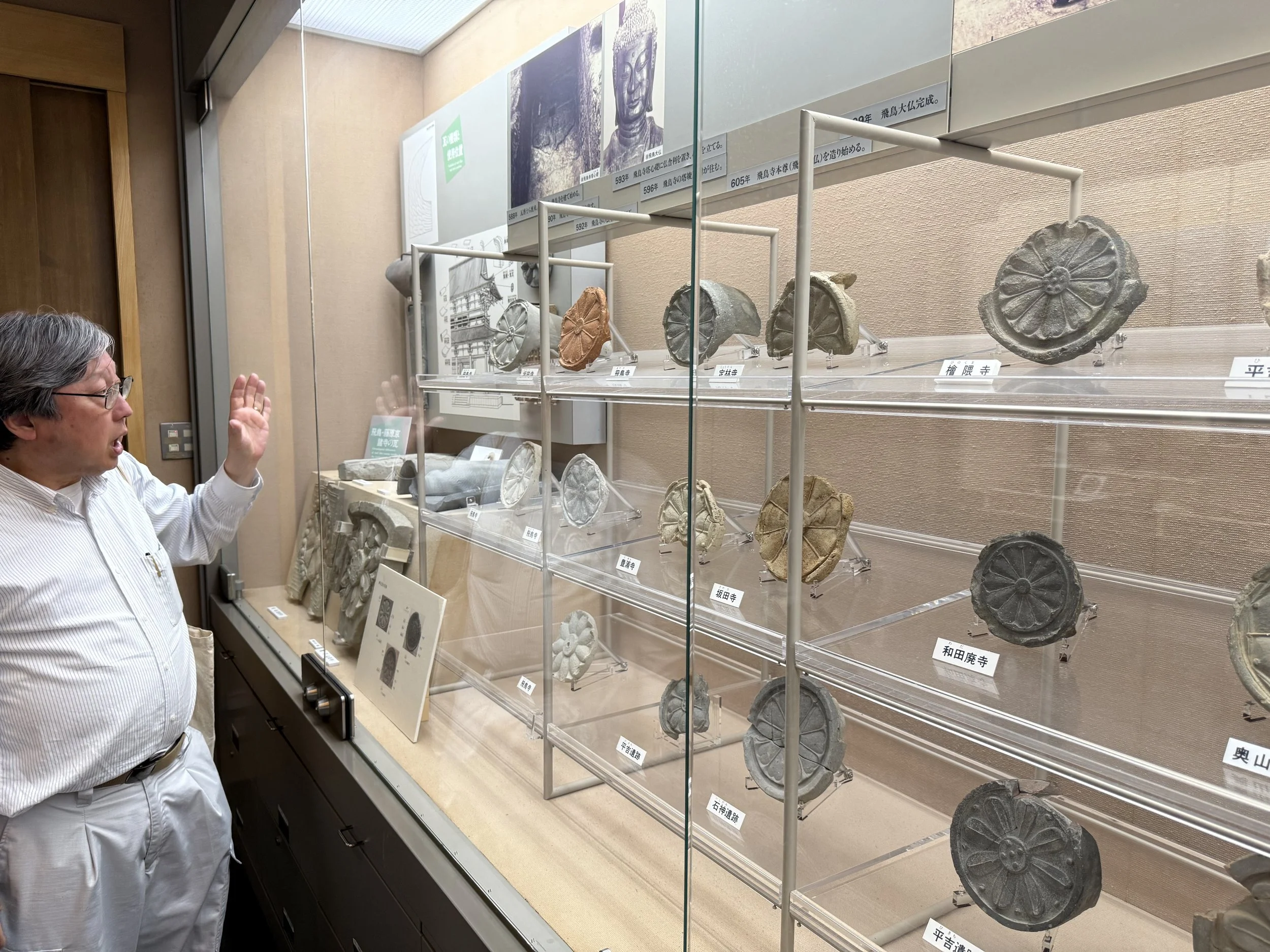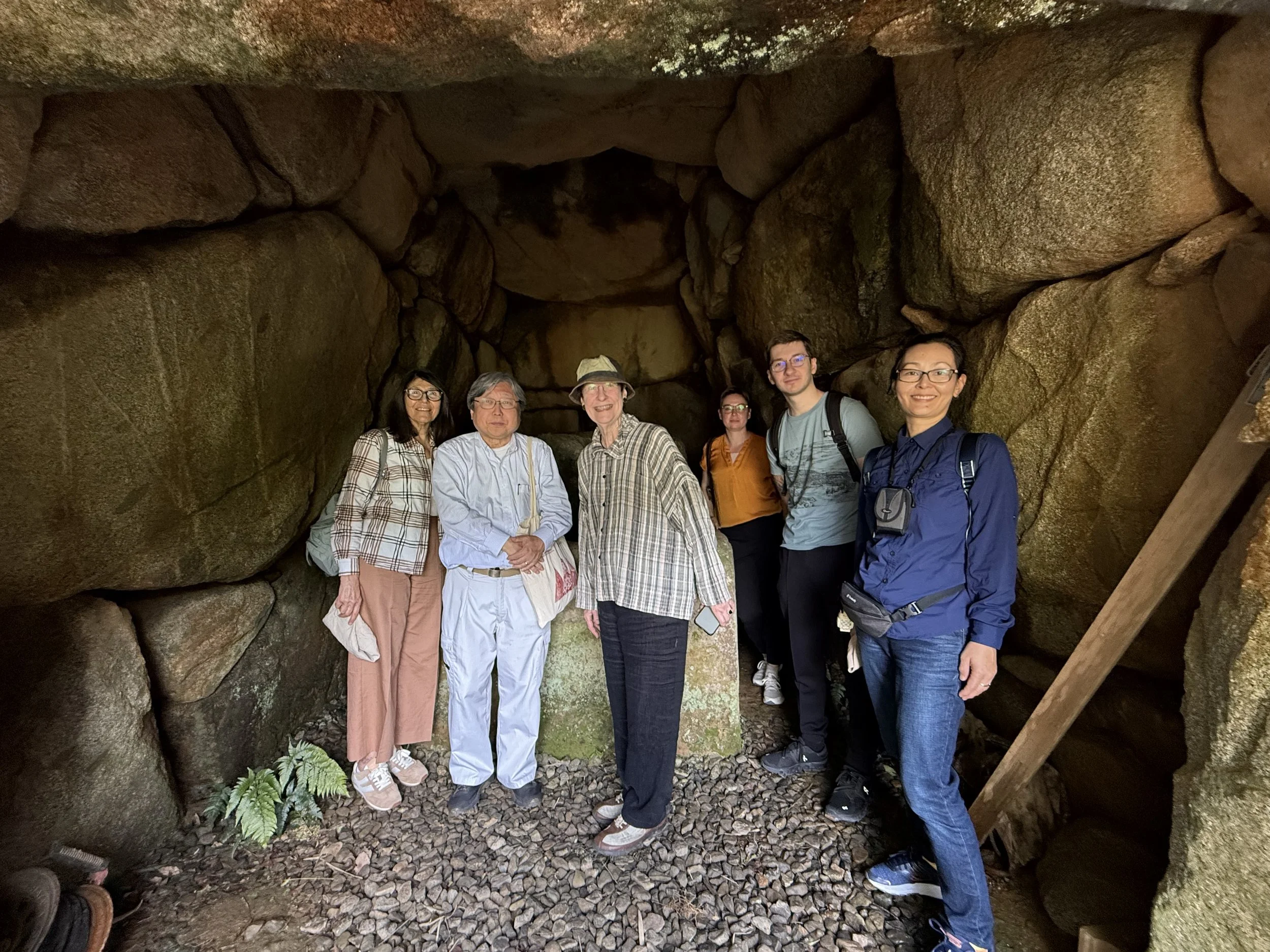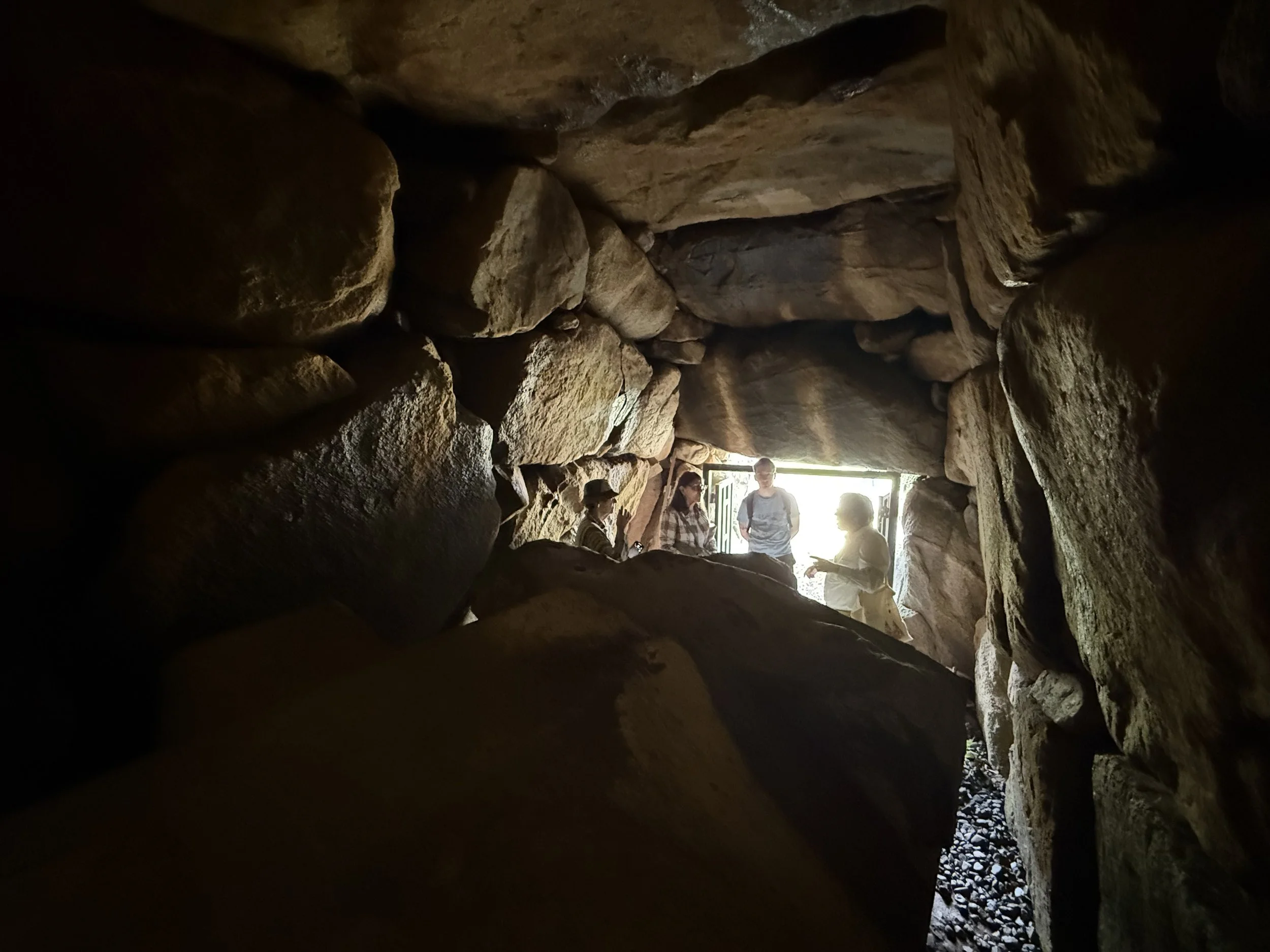USC-Meiji Archaeology Workshop
June 9-14, 2025
Prof. Sasaki guides participants around the Meiji University archaeology collection.
After a preliminary trip in the summer of 2023, in June 2025 USC and Meiji University held the innargual Archaeology Workshop with a focus on tombs of the Kofun period (300-538 CE). Students, postdoctoral and independent scholars met in Tokyo for an introductory session at the Meiji University museum. The next day, participants set out for Gunma, where they saw the Three Stelae of Kōzuke. Officials from the local government came out to give Workshop participants an up close view of the stelae, which reveal the early adoption of Buddhism by local elites. In addition, Prof. Sasaki introduced participants to notable local museums and re-constructions dedicated to the Kofun period. The second part of the Workshop was based in the Osaka-Nara region with explorations of the large tombs believed to hold early Yamato kings. With the support of local officials, museum staff, and scholars, participants were able to experience these monumental tombs in new ways and learn about exciting resources for teaching this important period.
Planning for the 2026 Archaeology Workshop is underway, with a tentative focus on early Buddhist temples. If you would like to receive more information, please contact us.
Favorite Sights and Experiences
Dr. Yoko Shirai
My most memorable, and favorite, sites were located in the neighboring cities of Takasaki 高崎 and Maebashi 前橋, Gunma prefecture. Prof. Ken’ichi Sasaki of Meiji University carefully selected and led our group to each of the interconnected sites, and walking into/around each site filled some of my extensive gaps in knowledge at a region in Japan unfamiliar to me―but I had long wanted to visit.
Buddhist statuary (primarily made of clay) recovered during modern archaeological campaigns at the ruins of Buddhist temples dating to the seventh and eighth centuries CE is my main area of specialization. So far, I focused on the earliest Buddhist temples in Japan that were predominantly constructed in or near the ancient capital cities located in present-day Nara and Osaka prefectures. Yet magnificent Buddhist temples were also built in distant locations during the second-half of the seventh century, such as those found in Gunma prefecture. The USC-Meiji University Archaeology Workshop gave me an opportunity to visit critical monuments, sites, and museums in Gunma prefecture for the first time and, even better, immediately ask Prof. Sasaki questions after hearing his concise lectures prepared for each site and delivered in situ. It was an amazing experience!
To be specific, the ruins of a Buddhist temple dated to the late seventh century was excavated in Maebashi city. The name of the temple was lost, so archaeologists identified the site as Sannō haiji ato 山王廃寺跡. Thousands of fragments of clay statuary were unearthed, as well as a massive and exquisitely carved heart-stone for a pagoda, and a monumental shibi 鴟尾or acroterion (a fish tail-shaped ornament secured at the end of a ridge on top of the roof). These objects closely reflect styles and practices used to build great temples in the capital. This much I knew. But after touring the Maebashi City Sōja History Museum (Maebashi shi Sōja rekishi shiryōkan 前橋市総社歴史資料館), not only did I see notable clay fragments of human heads excavated at Sannō haiji ato, two roof tiles with inscriptions were also on display: a sharp tool was used to hand-write “Hōkōji 方光寺” on one roof tile, and “Hōkō 方光” was stamped on the surface of one other roof tile. Recovering the lost name of a ruined temple is both rare and extraordinary, so this was an exciting discovery for me.
Prof. Sasaki of Meiji University explains the changes in temple roof tiles.
I asked Prof. Sasaki if more excavations―and more spectacular discoveries―are forthcoming at the Sannō haiji ato/ Hōkōji site and his answer was, “Yes!” This fills me with quiet anticipation as I wonder about what else might be unearthed. I also feel no rush to complete my research on this site because who knows what the years to come might reveal? But perhaps I need to change my priorities.
In the ancient past, an extraordinary expenditure of funds were used to construct Hōkōji, so who (or what group) sponsored the temple? Its location informs us about possible founders: about 1.7 km to the northeast, or 25 minutes on foot, lie a small group of colossal mounded tombs referred to as the Sōja kofungun 総社古墳群, dated between the second half of the fifth century and the end of the seventh century CE. Of particular note is the Sōja Futagoyama kofun総社二子山古墳. In the pouring rain on a Wednesday, 11 June 2025, we walked to two square-shaped mounded tombs dating to the seventh century: Hōtōzan kofun 宝塔山古墳 located just southwest of the Maebashi City Sōja History Museum, and Jaketsuzan kofun 蛇穴山古墳 directly to the south of the museum. Prof. Sasaki took us inside each tomb’s elaborate burial chambers lined with massive pieces of locally sourced, and neatly cut, stone. The tomb’s builders possessed an untold amount of capital (presumably economic and/or religious) to both acquire the material and to direct laborers to construct such massive tombs, so the same patrons―or their descendants―might have sponsored the construction of Hōkōji; since this trip was my first introduction to the Sōja kofungun, I still need to learn more about the tombs to fully grasp their historical context and significance.
Dr. Lisa Kochinski and graduate student Sophie Calderon examine the the text on the Yamanoue stele.
Another eye-opening experience (exposing my ignorance) was our visit to the “Three Stelae of Kōzuke” (Kōzuke sanpi 上野三碑). Large stones sourced locally were inscribed on one surface. The stelae are situated within six kilometers of each other, or an hour and a half trek on foot. I came away with the impression that this practice was popular around the end of the seventh to eighth centuries in this area, and there probably were additional inscribed stones that have yet to be discovered. In other words, the positioning of the three stelae did not seem planned as a coherent, intentional layout based on what I observed, but this is just a guess. One stele identified as the Yama no ue hi 山上碑 is of particular significance to my investigation of the Sannō haiji ato/ Hōkōji site, which lies about 17 km directly north of the Yamanoue stele and perhaps a four-hour walk. According to the brief inscription chiseled into the stony surface, this stele―now located on top of a hill in a mountainous, forested area―was dedicated by a monk named Nagatoshi (or Chōri?) 長利 in memory of his mother. Remarkably, the monk identifies himself as affiliated with the temple Hōkōji方光寺! In short, the material evidence indicates the prior existence of an important, local temple named Hōkōji, and I am convinced Hōkōji most likely corresponds to the ruined temple site of Sannō haiji ato.
Other construction projects in the vicinity also support this notion. As mentioned earlier, located about 1.7 km northeast of Sannō haiji ato are a group of colossal mounded tombs. Situated on the other side of the ruined temple, about 1.5 to 2 km south and southwest of Sannō haiji ato, are another critical group of structures dating from the early to mid-eighth century: these include the regional government center kokufu 国府 and the paired Kōzuke上野 Provincial Monastery (kokubunji 国分寺) and Provincial Nunnery (kokubunniji 国分尼寺). Upwards of a century passed between the construction of a temple at Sannō haiji ato and the pair of Provincial Temples (as ordered by the government centered in the eighth-century Heijō 平城 capital, now situated in present day Nara city). The concentration of major political and religious institutions or monuments in this area, all centered around Sannō haiji ato, indicates to me that Sannō haiji ato and its magnificent objects are traces of a prestigious temple sponsored by the local élite―namely Hōkōji.
Haniwa in the shape of horse with riding gear (left) and a deer (right).
So why here? Why did people actively travel to this distant location at a time when travel was dangerous and challenging? Hōkōji, the mounded tombs, and the three stelae reflect timely access to trends circulating in the seventh and eighth century capitals. Even today, Takasaki and Maebashi city are not easily accessible from major metropolitan areas. The current distance between the former Heijō capital to Takasaki city is 435 km. So if one walks 30 km/day, the journey takes at least two weeks as one traverses inland routes along mountain passes and foothills when available. As one explanation, this region in Gunma prefecture (with rivers, villages, and a grassy field that was covered by ash during catastrophic volcanic eruptions from the nearby volcano) possessed a major source of revenue that likely enabled selected residents to amass great wealth. That is, its geographical conditions, in addition to talented immigrants from the Korean peninsula, contributed to a formidable environment for raising and breeding horses since the time the colossal mounded tombs were first built in this region. I have been researching clay figures of horses, as either funerary clay cylinders (haniwa 埴輪) or as smaller clay images (doba 土馬), and these were made and used in this region. During our Workshop we certainly saw and learned a lot about horses being bred in Gunma prefecture since ancient times, and at local museums we came across iron fittings and ornaments used on actual horses that were recovered from mounded tomb chambers, in addition to images of horses (not life-size but smaller) made of clay. Horses were a valuable and highly sought-after commodity in Early Japan.
A Tomb You Can Touch
Dr. Emily Warren
Our travels and investigation began in Gunma, where we visited important stele, tombs of local elites, and museums. Then, traveling down from Tokyo to the Kansai region, we saw sites around Osaka and Nara. This trip was full of opportunities to question specialists, meet with museum staff and researchers, and visit notable sites for the Kofun and Asuka periods. I developed a new appreciation for the mounded tombs (kofun) and the methods that researchers are using to better understand these periods prior to robust historical records. Rather than going point-by-point through the trip, I want to share some moments from our travels I found especially moving and transformative.
In Gunma at the Yama no Ue stele, I was able to stand right beside writing from the seventh century after representatives from the city came out to open the buildings containing the stele and answer our questions. The stele, one of three we visited across Gunma, contained a declaration of Buddhist devotion by a man and notes about the efforts of his mother for the relatively new religion. Beside the stele was a modest mounded tomb, one built at the end of the period of such tomb-building. This stele and tomb formed a bridge from the Kofun period into the Asuka for me; local elite families throughout the archipelago transitioned from building monumental tombs to building Buddhist temples instead, and here was evidence of Buddhist faith and practice far from the courts of the Kinai, just beside a tomb. After studying the writing carved into the stele, we walked outside and stared at the mounded tomb. Because this was a smaller tomb, unlike the monumental tombs that are protected and restricted in other parts of Japan that I had seen on prior trips to Japan, it was possible to go inside and experience this space.
As Dr. Shirai and I climbed into the seventh-century mounded tomb and started crawling, I realized the work it would take for locals to position the deceased inside. If there was a sarcophagus, it would have to be dragged by a small team on their hands and knees or somehow deposited inside before the mound was completed. Or perhaps, a body would have undergone decomposition in another site before being prepared to be entombed here, something we discussed in a local museum afterwards. Either way, I was made viscerally aware of the work that went into a modest tomb for the local elite. Ahead of me, Dr. Shirai gave a shriek. There was something crawling around us. When we turned our flashlights up to investigate, streams of large crickets crept across on the ceiling, fleeing from the light.
In the days to come, we would see these insects creeping in the tombs, but again, their presence highlighted the extraordinary craftsmanship that went into even the most modest of the mounded tombs; the massive blocks, so cleanly cut and finished, did not leave large enough gaps for the crickets to hide in, leaving them to scurry about the ceiling and walls in the open. At the opposite end of the tomb’s main chamber were two Buddhist statues. These were undoubtably later additions, said Dr. Shirai, and dragged into the tomb many hundreds of years later by people living in the village. A missing block on the far wall presented a place where tomb-robbers likely had broken in; I assume, prior to the addition of the Buddhist states. Crouched in this little tomb that would never make it into a textbook, I began to understand the effort that goes into constructing such a memorial with mere man-power and how these places continue to exist in communities far beyond the era of their initial construction. After studying the smooth walls, which would be typically covered with plaster and painted, we crawled out of the tomb. The city representatives outside were answering questions, and I was surprised to learn that the Buddhist statues, those “later additions,” dated from the thirteenth or fourteenth centuries.
In fact, the existence of tombs within communities would continue to be a theme for me over the course of the trip. When we visited Kamitsukeno Sato Museum of Archaeology, Prof. Sasaki made a point of taking us over to a large diorama depicting the construction of the local monumental mounded tomb. The head archaeologist working on the site maintained that willing particpation in local tomb construction was vital; it would not have been possible to used forced labor or conscription for these projects. Locals had to believe in memorializing the entombed people, or else suffer the wrath of deities. Or, if made to be too miserable, they would refuse to engage with such construction in the future.
Prof. Sasaki elaborated on this interpretation and pointed out the resting places, shaded pavilions where laborers could lounge, as well as where haniwa statues would be fired or rocks cut by locals. Within that same museum were exhibitions on village daily life. In the fifth century, Mt. Haruna erupted and buried sections of Kamitsukeno Sato in volcanic ash and debris. This eruption created a snapshot of early village life for archaeologists, a sort of Japanese Pompeii. Prof. Sasaki explained that the village site “preserved” by the eruption revealed below-ground and above-ground dwellings, artifacts of Korean peninsular migrations, and even the layout of paddies. The museum collection and physical objects made this period more vibrant and real for me than an article ever had. I stood for a while in front of a case containing a bent and twisted heap of melted armor, worn by a man standing in front of a woman and child when the volcano erupted, this cutting edge technology and defense powerless before the volcano. Perhaps, as archaeologists have suggested, he was trying to protect his family.
In Osaka at the large Imashirozuka Mounded Tomb, careful recreations by researchers and archaeologists allowed us to literally walk amongst the haniwa. A researcher from the Imashirozuka Museum explained to us that the haniwa were arranged on the mounded tomb in scenes, like snapshots of palace life. At Imashirozuka, there were recreations of ritualists making offerings, hunters with deer, sumo wrestlers, and miniature buildings that came up to chest-high. Through the haniwa recreations, as well as the originals in the museum, we could better imagine life in the sixth-century: costumes, architecture, hairstyles, and animals. But as I stepped around the earthenware cylinders and lines of clay waterfowl, I experienced walking over the mounded tomb and looking at the scenes in a similar manner as locals might have in the years after the construction of the mound and the firing of the haniwa at the massive workshop nearby. In the nearby museum, I saw the sarcophagus-making tools and reconstructions, which again made real the material of memorial and death rites in the lives of workers and mourners. After delighting in the pink stone used for one of the sarcophagi, I learned that people selected a quarry, drew this unique stone, and hauled it overland onto boats, and transported all the way from Kyushu to the Kinai.
Workshop participants explore the Ishibutai Mounded Tomb.
By being onsite, I could imagine all kinds of other facets of living around and making the tombs through sight, touch, and listening. At the open tombs we visited, I could run my fingers over the cut stone on the inside of a tomb and experience the transformation of memorial sites over time. At the Miyakotsuka Mounded Tomb from the sixth century, we could barely make our way around the large sarcophagus and the exposed stone inner walls. Workers, Prof. Sasaki explained, would have lashed ropes around protrusions on the stone sarcophagus to pull it into the tight space. Nearby, the Ishibutai Mounded Tomb had no mound, the cut stones exposed by the ruins of the mound. A breeze now blew through the tomb once built for the leader of one of the most powerful clans of the Kinai region.
The mound formations and sarcophagus shapes and sizes varied over century and region; for years I have worked off of diagrams showing the changes in tombs over the course of the Kofun period, but by crawling into local tombs, listening to local researchers, and walking along the haniwa was I able to better imagine the lives of not just the elite deceased, but the people who constructed these monuments and lived aside them.











